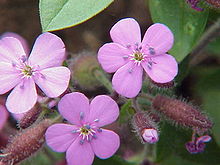Saponaria
| Saponaria | |
|---|---|

| |
| Saponaria ocymoides | |
| Scientific classification | |
| Kingdom: | Plantae |
| Clade: | Tracheophytes |
| Clade: | Angiosperms |
| Clade: | Eudicots |
| Order: | Caryophyllales |
| Family: | Caryophyllaceae |
| Genus: | Saponaria L.(1753) |
| Species | |
|
30-40, see text | |
| Synonyms[1] | |
| |
Saponariais agenusofflowering plantsin thefamilyCaryophyllaceae,nativeto Asia and Europe, and are commonly known assoapworts.[2]They areherbaceousperennialsandannuals,some with woody bases. The flowers are abundant, five-petalled and usually in shades of pink[3]or white.[2]The genus is closely related to the genusSilene,being distinguished from these by having only two (not three or five)stylesin the flower.[3]It is also related toGypsophila,but itscalyxis cylindrical rather than bell-shaped.[4]
The most familiar species might becommon soapwort(S. officinalis), which is native to Eurasia but is known in much of the world as anintroduced species,often aweed,and sometimes a cultivatedornamental plant.[2]The genus nameSaponariaderives from the Latinsapo( "soap" ) and -aria( "pertaining to" ),[2]and at least one species,S. officinalis,has been used to makesoap.[5]It containssaponins,and a liquid soap can be produced by soaking the leaves in water.[2]This soap is still used to clean delicate antique tapestries.[6]It is also sometimes stated that it is used as anemulsifierinTurkish delightconfections, but this is a case of double confusion. The roots of plants in genusGypsophilaare used to make the Turkish confectionhelvaandSaponariaspecies are not used.[7]
Saponariaspecies are eaten by thelarvaeof somebutterflies and moths,including theLychnisandColeophora saponariella,which is exclusive to the genus.
Diversity
[edit]There are thirty[4][8]to forty[2][9][10]species in the genus.
Plants of the World Onlineaccepts 39 species:[1]
- Saponaria aenesiaHeldr.
- Saponaria bargylianaGomb.
- Saponaria bellidifoliaSm.
- Saponaria biovulata(Stapf) Barkoudah
- Saponaria bodeanaBoiss.
- Saponaria caespitosaDC.
- Saponaria calabricaGuss.
- Saponaria cerastoidesFisch. ex C.A.Mey.
- Saponaria cypriaBoiss.
- Saponaria dalmasiH.Boissieu
- Saponaria emineanaGemici & Kit Tan
- Saponaria glutinosaM.Bieb.
- Saponaria griffithianaBoiss.
- Saponaria gypsaceaVved.
- Saponaria halophilaHedge & Hub.-Mor.
- Saponaria iranicaDashti, Assadi & Sharifnia
- Saponaria jageliiPhitos & Greuter
- Saponaria karapinarensisVural & Adıgüzel
- Saponaria kotschyiBoiss.
- Saponaria luteaL.
- Saponaria mesogitanaBoiss.
- Saponaria ocymoidesL.
- Saponaria officinalisL.
- Saponaria orientalisL.
- Saponaria pachyphyllaRech.f.
- Saponaria pamphylicaBoiss. & Heldr.
- Saponaria pictaBoiss.
- Saponaria pinetorumHedge
- Saponaria prostrataWilld.
- Saponaria pumilaJanch.
- Saponaria pumilioBoiss.
- Saponaria sewerzowiiRegel & Schmalh.
- Saponaria siculaRaf.
- Saponaria stenopetalaRech.f.
- Saponaria subrosularisRech.f.
- Saponaria suffruticosaNábělek
- Saponaria syriacaBoiss.
- Saponaria tadzhikistanica(Botsch.) V.A.Shultz
- Saponaria tridentataBoiss.
References
[edit]- ^ab"SaponariaL. "Plants of the World Online.Royal Botanic Gardens, Kew.Retrieved9 March2024.
- ^abcdefThieret, John W.; Rabeler, Richard K. (2005)."Saponaria".In Flora of North America Editorial Committee (ed.).Flora of North America North of Mexico (FNA).Vol. 5. New York and Oxford: Oxford University Press – via eFloras.org,Missouri Botanical Garden,St. Louis, MO &Harvard University Herbaria,Cambridge, MA.
- ^abRHS A–Z Encyclopedia of Garden Plants.United Kingdom: Dorling Kindersley. 2008.ISBN978-1405332965.
- ^abGhazanfar, Shahina A.; Nasir, Yasin J."Saponaria".Flora of Pakistan– via eFloras.org,Missouri Botanical Garden,St. Louis, MO &Harvard University Herbaria,Cambridge, MA.
- ^Coombes, A. J. (2012).The A to Z of Plant Names.USA: Timber Press. p.265.ISBN9781604691962.
- ^Elliot, Doug (July 1995).Wild Roots: Forager's Guide to the Edible and Medicinal Roots, Tubers, Corms and Rhizomes of North America.Inner Traditions / Bear & Co.ISBN978-0892815388.
- ^Işın, Priscilla Mary (2013).Sherbet & Spice: the complete story of Turkish sweets and desserts(1st ed.). New York: I.B. Tauris. pp. 128, 270.ISBN978-1-84885-898-5.Retrieved9 March2024.
- ^Lu, Dequan; Lidén, Magnus; Oxelman, Bengt."Saponaria".Flora of China.Vol. 6 – via eFloras.org,Missouri Botanical Garden,St. Louis, MO &Harvard University Herbaria,Cambridge, MA.
- ^Jürgens, Andreas; Witt, Taina; Gottsberger, Gerhard (2003)."Flower scent composition inDianthusandSaponariaspecies (Caryophyllaceae) and its relevance for pollination biology and taxonomy "(PDF).Biochemical Systematics and Ecology.31(4): 345–57.Bibcode:2003BioSE..31..345J.doi:10.1016/S0305-1978(02)00173-4.
- ^Hartman, Ronald L.; Rabeler, Richard K. (2012)."Saponaria".In Jepson Flora Project (ed.).Jepson eFlora.The Jepson Herbarium,University of California, Berkeley.
External links
[edit]- Saponaria.ITIS.
